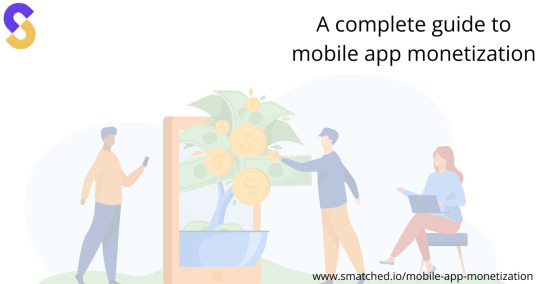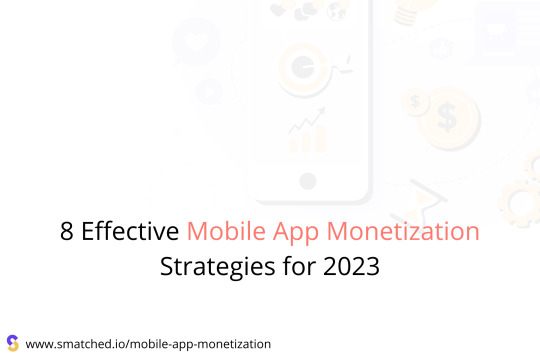Smatched is a specialized mobile app monetization platform Let s get some app monetization ideas and boost your revenue
Don't wanna be here? Send us removal request.
Text
A complete guide to mobile app monetization

Monetizing a mobile app can be a complex process, but it's essential for sustaining your app and generating revenue. Here's a comprehensive guide to mobile app monetization:
Understand Your Target Audience:
Before choosing a monetization strategy, understand your users' preferences, behavior, and demographics. This will help you tailor your approach.
Choose the Right Monetization Strategy:
There are various monetization methods to consider:
In-App Advertising:
Banner Ads: Displayed at the top or bottom of the app's interface.
Interstitial Ads: Full-screen ads that appear at natural breaks in the app.
Video Ads: Short video clips users can watch for in-app rewards.
Native Ads: Seamlessly integrated ads that match the app's design.
In-App Purchases (IAP):
Offer digital goods or premium features for purchase within the app.
Subscriptions:
Charge users a regular fee to access premium content or features.
Freemium Model:
Provide a free version of the app with limited features and offer premium upgrades.
Sponsorships and Partnerships:
Partner with brands for co-branded content or events.
Affiliate Marketing:
Promote other products or services within your app and earn a commission.
E-commerce:
Sell physical or digital products directly through your app.
Optimize User Experience:
Ensure that your monetization methods don't hinder the user experience. Intrusive ads or excessively aggressive monetization can drive users away.
A/B Testing:
Experiment with different monetization strategies and measure their impact on user engagement, retention, and revenue. Adjust your approach based on the results.
Data Analytics:
Use analytics tools to track user behavior, preferences, and revenue generation. This data can help refine your monetization strategy.
Implement Effective Ad Targeting:
If using ads, implement ad targeting to show relevant ads to users, increasing the chances of clicks and conversions.
App Store Optimization (ASO):
Optimize your app's name, description, keywords, and visuals to improve discoverability in app stores. A higher number of downloads can lead to more revenue.
Build a Strong User Base:
Focus on acquiring and retaining users. A larger user base provides more opportunities for monetization.
Localize Your App:
If your app has a global audience, consider localizing it to reach a wider range of users and potentially increase revenue.
User Support and Feedback:
Provide excellent customer support to address user concerns and feedback promptly. Happy users are more likely to engage with your app and its monetization options.
Comply with Regulations:
Ensure your monetization strategies comply with privacy and data protection regulations, such as GDPR and CCPA.
Continuous Improvement:
Mobile app monetization is an ongoing process. Stay updated with industry trends and adjust your strategy accordingly.
Security and Privacy:
Protect user data and provide clear privacy policies to build trust with your audience.
Diversify Your Income Streams:
Avoid relying on a single monetization method. Diversify your income streams to reduce risk and maximize revenue.
Promote Your App:
Use marketing techniques, such as social media, influencer marketing, and public relations, to increase your app's visibility.
Monitor Competition:
Keep an eye on your competitors' monetization strategies and adapt as needed to stay competitive.
User Feedback Loop:
Continuously gather feedback from users to understand their needs and adapt your monetization strategies accordingly.
Educate Your Team:
Ensure that your development and marketing teams are well-informed about the chosen monetization strategy and its implementation.
Legal and Ethical Considerations:
Be aware of and follow legal and ethical standards, such as COPPA for apps targeting children. Remember that successful mobile app monetization often requires a combination of strategies. It may take time to find the right balance between user satisfaction and revenue generation. Be flexible and willing to adapt your approach as you gain more insights into your app's user base and market conditions.
0 notes
Text
8 Effective Mobile App Monetization Strategies for 2023

Monetizing a mobile app in 2023 requires a strategic approach that takes into account the evolving trends in the app market, user preferences, and industry regulations.
Here are eight effective mobile app monetization strategies for 2023:
In-App Advertising:
Banner Ads: Incorporate non-intrusive banner ads within your app's interface.
Interstitial Ads: Display full-screen ads between app content transitions.
Video Ads: Show short video ads, often with rewards for users who watch them.
Native Ads: Blend advertisements seamlessly into the app's content for a more natural experience.
2. Subscription Models:
Offer premium content or features behind a paywall.
Provide tiered subscription options (e.g., monthly, yearly) to cater to different user preferences.
Implement a free trial period to encourage users to subscribe.
3. Freemium Model:
Allow users to download and use the app for free with basic features.
Offer premium upgrades or virtual goods within the app for a fee.
Employ limited-time offers and discounts to entice purchases.
4. In-App Purchases (IAP):
Sell virtual items, power-ups, or currencies that enhance the user experience.
Implement a well-balanced economy to maintain user engagement.
Regularly introduce new items and incentives to keep users spending.
5. Affiliate Marketing:
Partner with relevant brands or services to promote their products within your app.
Earn commissions for every successful referral or purchase generated through your app.
6. Sponsorship and Partnerships:
Collaborate with businesses or influencers in your niche to sponsor app content or events.
Offer branded experiences or exclusive content to users as part of the partnership.
7. Data Monetization:
Collect user data responsibly and anonymize it to protect privacy.
Sell aggregated, non-personal data to businesses looking for market insights and trends.
8. Crowdfunding and Donations:
Implement crowdfunding campaigns or accept donations from loyal users who want to support your app.
Offer exclusive perks or recognition to donors as a token of appreciation.
Additional Tips:
User Experience (UX): Ensure a smooth and enjoyable user experience. Intrusive ads or overly aggressive monetization can drive users away.
A/B Testing: Continuously experiment with different monetization strategies to find the most effective ones for your app and user base.
User Feedback: Listen to user feedback and adjust your monetization strategies accordingly. Users appreciate transparency and responsiveness.
Compliance: Stay up-to-date with data privacy regulations (e.g., GDPR, CCPA) and ensure your app's monetization practices are compliant.
Localization: Consider regional differences in user preferences and spending habits when implementing monetization strategies.
Analytics: Utilize analytics tools to track user behavior, conversion rates, and revenue metrics to make informed decisions.
Remember that a successful monetization strategy often involves a combination of these approaches, and the specific strategy you choose should align with your app's niche, target audience, and overall goals. Flexibility and adaptability are key to staying competitive in the ever-evolving mobile app market.
2 notes
·
View notes